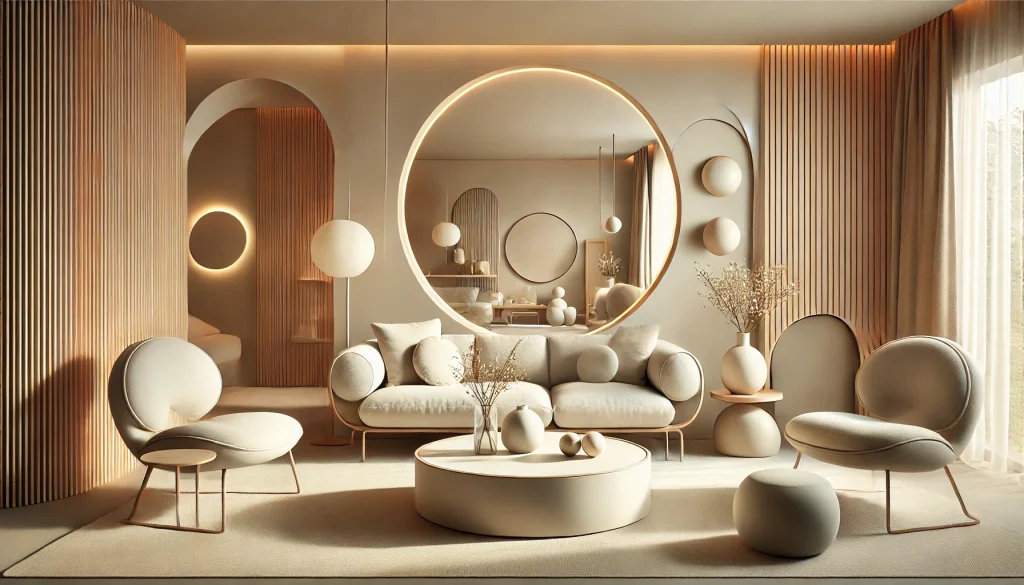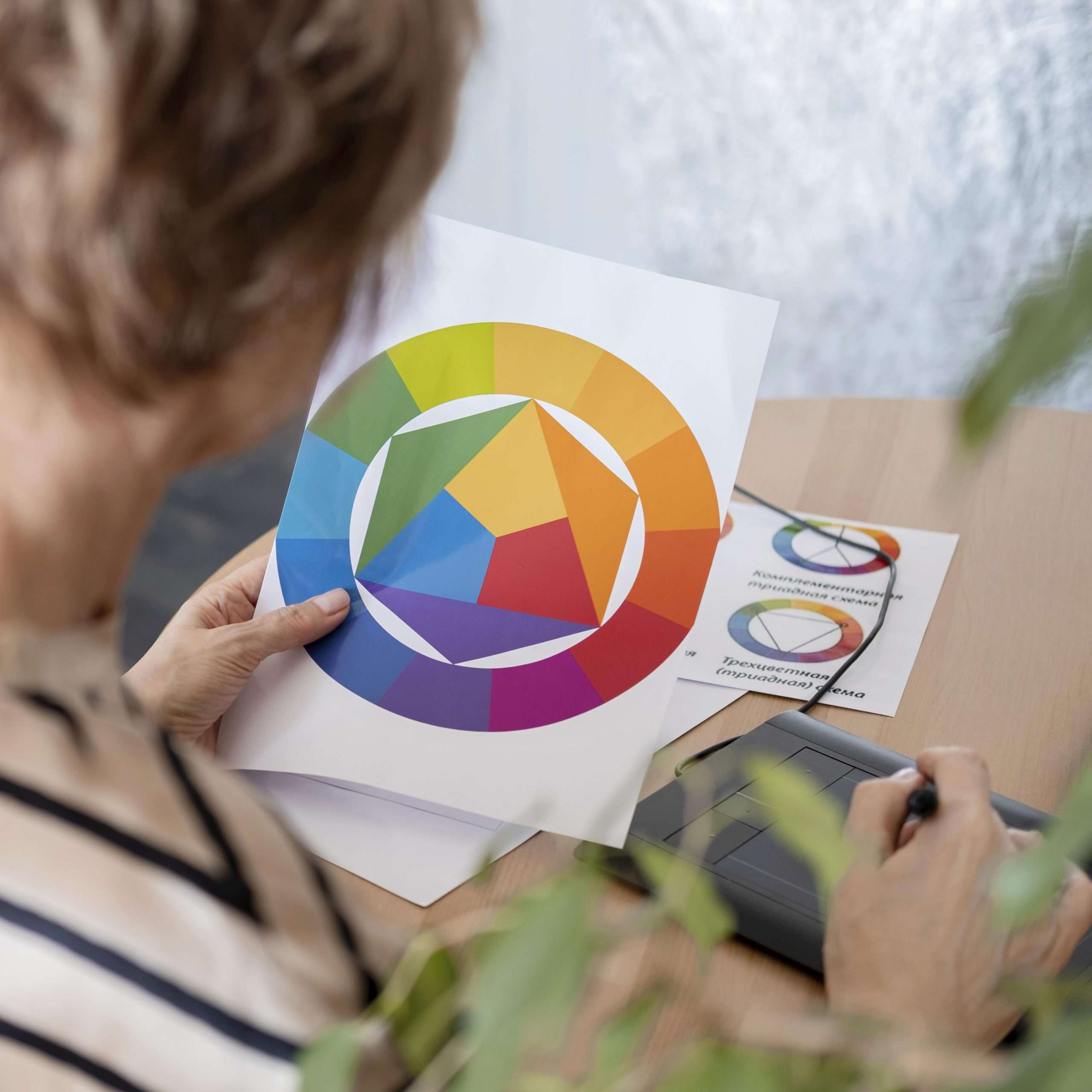When it comes to interior design, most people focus on color schemes, textures, and furniture placement. But one crucial, often overlooked element is the psychology of shapes and how geometry impacts our perception of space. The shapes we incorporate into our living environments, from furniture to décor to architectural elements, can evoke different emotional responses, influence mood, and even affect how we experience the flow of a room.
1. Circles: Softness, Unity, and Fluidity
Circular shapes are one of the most powerful tools in interior design, often evoking feelings of unity, continuity, and inclusivity. Their lack of sharp corners makes them soft and approachable, creating a sense of flow and harmony.
– Round Furniture and Decor: Incorporating round tables, rugs, or ottomans helps soften a room’s hard edges and makes the space feel more relaxed and welcoming. Circular dining tables encourage conversation and connection, while round mirrors or light fixtures can serve as elegant focal points.
– Creating Balance: If your space has a lot of sharp angles or straight lines, introducing round or curved elements can create visual balance. The curves contrast with linear geometry, making the room feel more dynamic yet harmonious.
– Fluidity and Movement: Circular shapes naturally draw the eye around the room, creating a sense of flow. Using curved furniture or arched doorways can guide movement through a space, making it feel more open and connected.
2. Squares and Rectangles: Stability, Structure, and Order:
Squares and rectangles are among the most common shapes in interior design because they represent stability, structure, and balance. These shapes are practical and predictable, making them ideal for creating a sense of order.
– Furniture and Layout: Most furniture comes in square or rectangular forms — think sofas, tables, cabinets, and bookshelves. These shapes help anchor a room and create a sense of order and organization. When arranging rectangular furniture, it’s important to balance it with other shapes to avoid making the space feel too rigid or boxy.
– Grid Patterns: Rectangular or square patterns, like grid-style wall décor or shelving units, can add structure and symmetry to a room. These shapes evoke a sense of logic and practicality, perfect for home offices, kitchens, or any space where focus and productivity are key.
– Architectural Elements: Rectangular windows, doors, and flooring are common architectural features that give a sense of uniformity and stability. While these shapes provide structure, combining them with softer shapes (like round lighting or curved furniture) can prevent the room from feeling overly rigid.

3. Triangles: Energy, Direction, and Strength
Triangles are bold, dynamic shapes that symbolize energy, movement, and strength. Their sharp points naturally direct the eye, making them perfect for creating visual interest or highlighting specific areas of a room.
– Bold Accents: Using triangular shapes in design elements, such as shelving, wall art, or patterned textiles, can inject energy into the room. Because of their angular nature, triangles are great for adding a modern, edgy vibe to the space.
– Directional Cues: Triangles can direct attention to certain areas of the room, making them a great tool for guiding movement. For example, triangular light fixtures or sculptures can draw the eye upward, making the ceiling feel higher or emphasizing architectural features like beams or vaulted ceilings.
– Creating Focus: Triangular shapes can also serve as focal points. Whether it’s a statement piece of furniture or a geometric rug with sharp angles, triangles help add energy and vibrancy, making them ideal for living rooms, home offices, or creative spaces.
4. Curves and Organic Shapes: Comfort, Relaxation, and Calm
In contrast to sharp, angular shapes, curves and organic shapes have a natural, calming effect. These shapes mimic forms found in nature and bring a sense of relaxation and ease to a room.
– Curved Furniture: Pieces like rounded sofas, arched chairs, or crescent-shaped décor elements can create a cozy, inviting atmosphere. These organic shapes are perfect for bedrooms, living rooms, or reading nooks where comfort and relaxation are a priority.
– Flow and Flexibility: Curved lines naturally guide the flow of a space, making the room feel more flexible and open. Whether through curvy architectural details or wave-like patterns in textiles, curves help soften the overall design, encouraging a sense of comfort and ease.
– Natural Influence: Incorporating organic shapes inspired by nature, such as irregular wooden furniture or abstract sculptures, brings an element of the outdoors inside. These shapes ground the space in a sense of calm, connecting it with the serenity of nature.
5. Hexagons and Geometric Patterns: Playfulness and Modern Edge
Hexagons and other geometric shapes offer a unique way to introduce a sense of playfulness and modernity into a space. Their multi-sided nature brings complexity and dynamism, making them ideal for adding visual interest.
– Geometric Tiles and Textiles: Hexagonal tiles in bathrooms, kitchens, or backsplashes create a fresh, modern look that’s both stylish and versatile. Similarly, geometric-patterned cushions, throws, or rugs can add vibrancy to a neutral room, instantly making it feel more contemporary and fun.
– Wall Art and Décor: Using hexagonal shelves or geometric wall art as décor can create a striking visual centerpiece in any room. These shapes are perfect for those who love bold, modern design and want to make a statement in their home.
– Layering Patterns: When incorporating geometric shapes into your design, layer different patterns to add depth and dimension without overwhelming the space. For example, pairing hexagonal floor tiles with softer, curved furniture can create an exciting contrast while maintaining balance.
6. Using Shapes to Enhance Functionality
Beyond aesthetics, shapes in interior design can also enhance the functionality of a space. The right geometric choices can guide movement, create focal points, or define specific areas within a room.
– Zoning with Shapes: In open-concept spaces, using different shapes to define distinct zones can enhance functionality. A circular rug can anchor a seating area, while rectangular tables create more formal dining or workspaces.
– Flow and Navigation: The geometry of a room can direct how people move through it. Arched doorways and curved pathways make the space feel more inviting, while linear elements like hallways or rectangular rugs help direct traffic flow.
The shapes we incorporate into our interior design are more than just aesthetic choices — they can affect the mood, energy, and functionality of a space. By thoughtfully selecting and balancing shapes like circles, rectangles, triangles, and organic forms, you can create a harmonious environment that not only looks beautiful but feels great to live in.
Understanding the psychology of shapes allows for more intentional and impactful design decisions. Whether you’re looking to create a space that feels soft and inviting or bold and dynamic, the right geometry can help you achieve your vision while enhancing the overall experience of your home.






